Asus ZenBook 14 UX425E Review
The Asus ZenBook brand is the byword for attainable luxury, and the UX425 is the latest model to emerge with the brushed metal and sleek pattern associated with these machines. The most interesting affair here isn't the exterior, though – it's the interior. This ZenBook is among the offset laptops nosotros've seen with one of Intel'south Tiger Lake CPUs.
The fleck of selection is the Core i7-1165G7, which is set to get ane of the most popular Tiger Lake offerings – it'south already actualization in loads of laptops, and the preceding i7-1065G7 was everywhere.
Nosotros have a detailed review on this new laptop CPU, just in a nutshell, the new Core i7 promises improved operation thanks to an improved manufacturing procedure and more than versatility when it comes to clock speeds – aslope back up for new features like Thunderbolt four, PCI-E four.0, and improved integrated graphics.
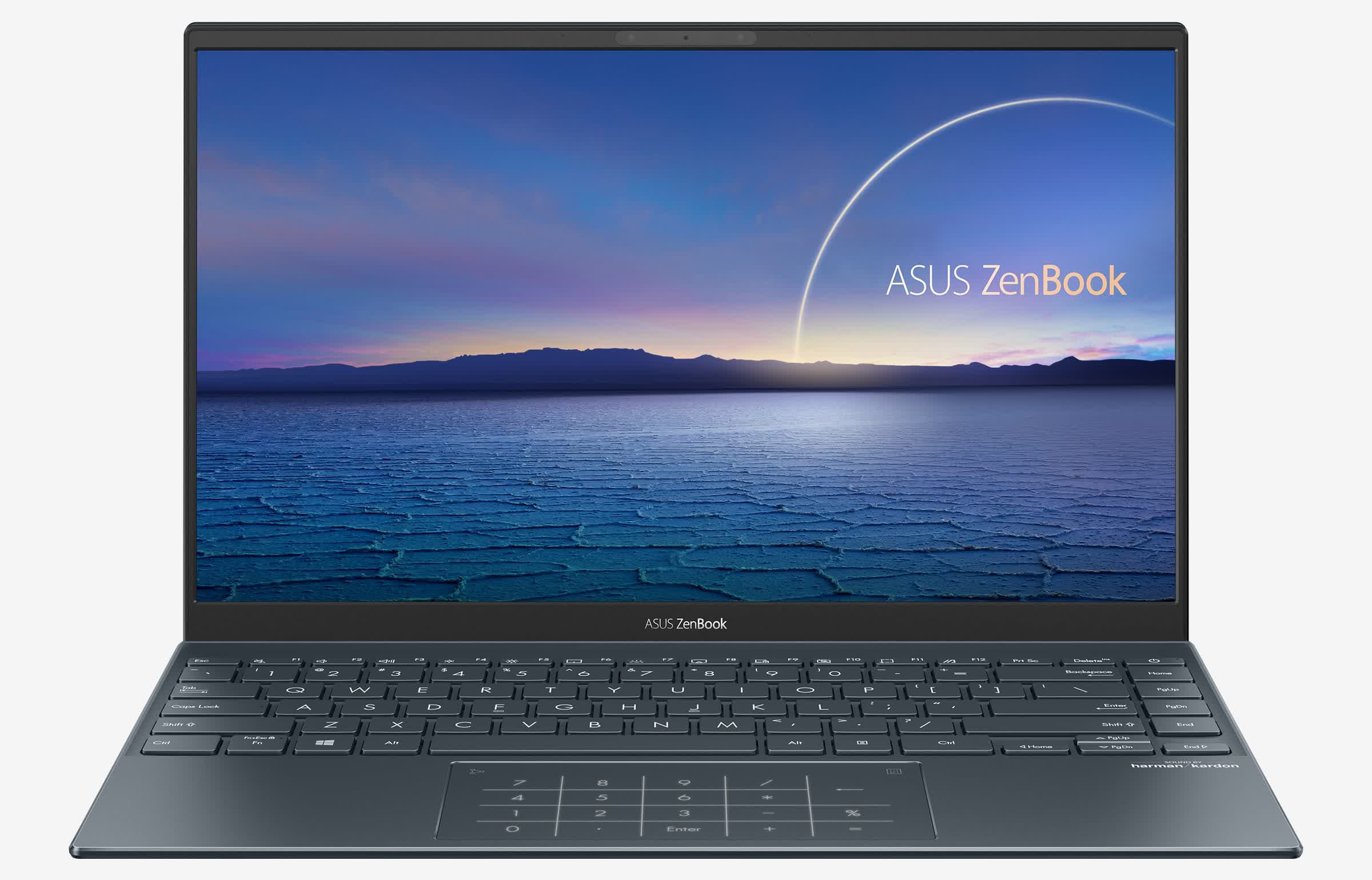
It's a fiercely competitive era in the laptop market, though. Intel may be making big claims about its new chip, only CPUs like AMD's Ryzen v 4500U and Ryzen seven 4700U are ready to compete with Intel, and other machines are nevertheless finding success with the i7-1065G7.
The ZenBook xiv configured equally our sample unit (16GB RAM/1TB SSD) costs around $one,099, while the base $899 version comes with half of the memory and storage chapters.
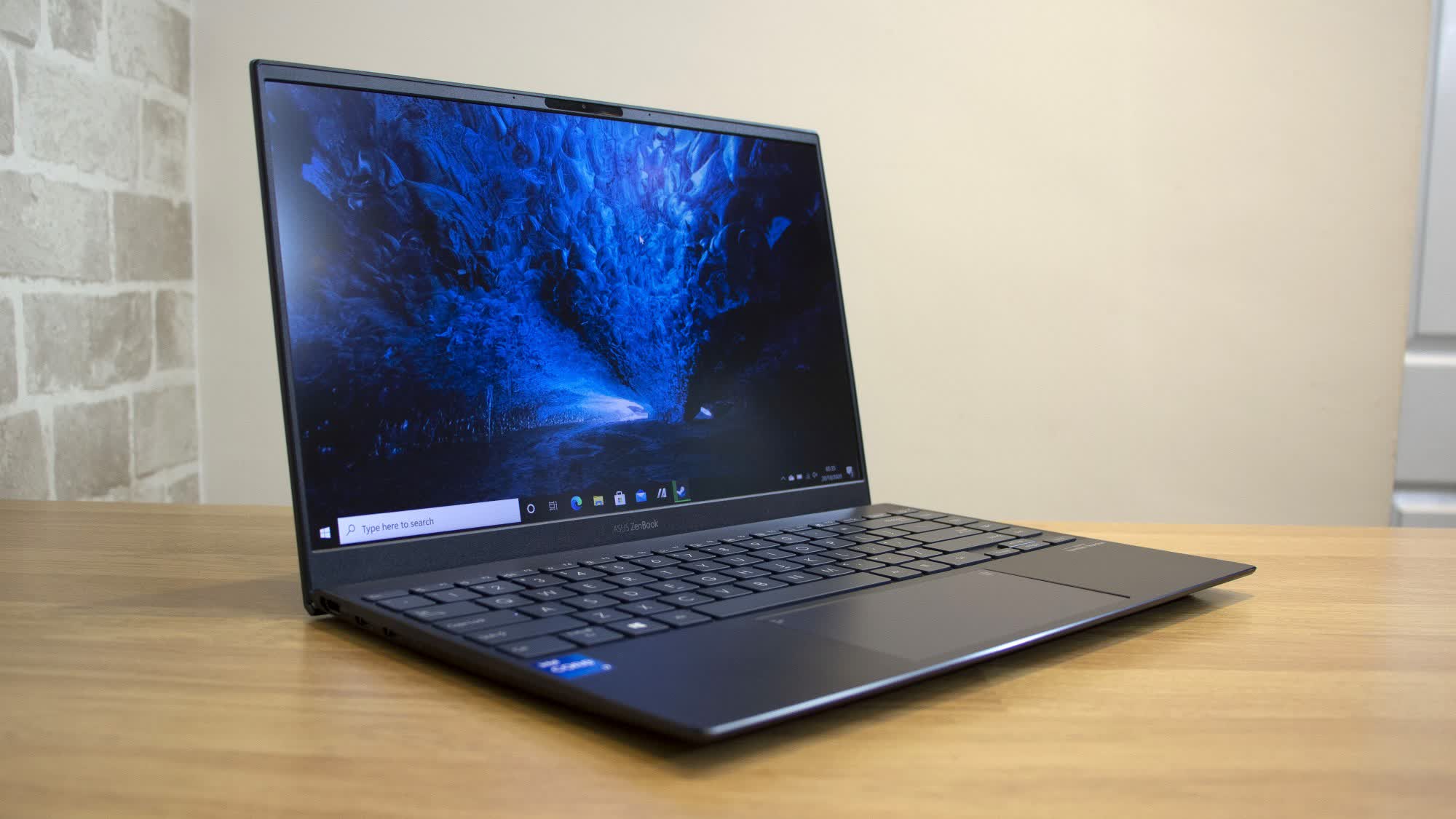
Features and Pattern
The UX425 is unmistakably a ZenBook. The chapeau is built from aluminum alloy and finished in a smart, subtle concentric circle design focused effectually the shining, off-centre Asus logo. Opening the machine reveals more alloy in the same dark shade. The shape is sleek, with a tapered front end border and slim bezels on both sides of the screen. The laptop can be opened smoothly with your fingertip.
The rear has a modest ErgoLift hinge, which tilts the keyboard towards the user, and the underside is minimal, with one wide air vent and four safe feet. The ErgoLift design means that the lesser bezel is a lilliputian too mesomorphic, and it doesn't permit for the display to lay completely flat.
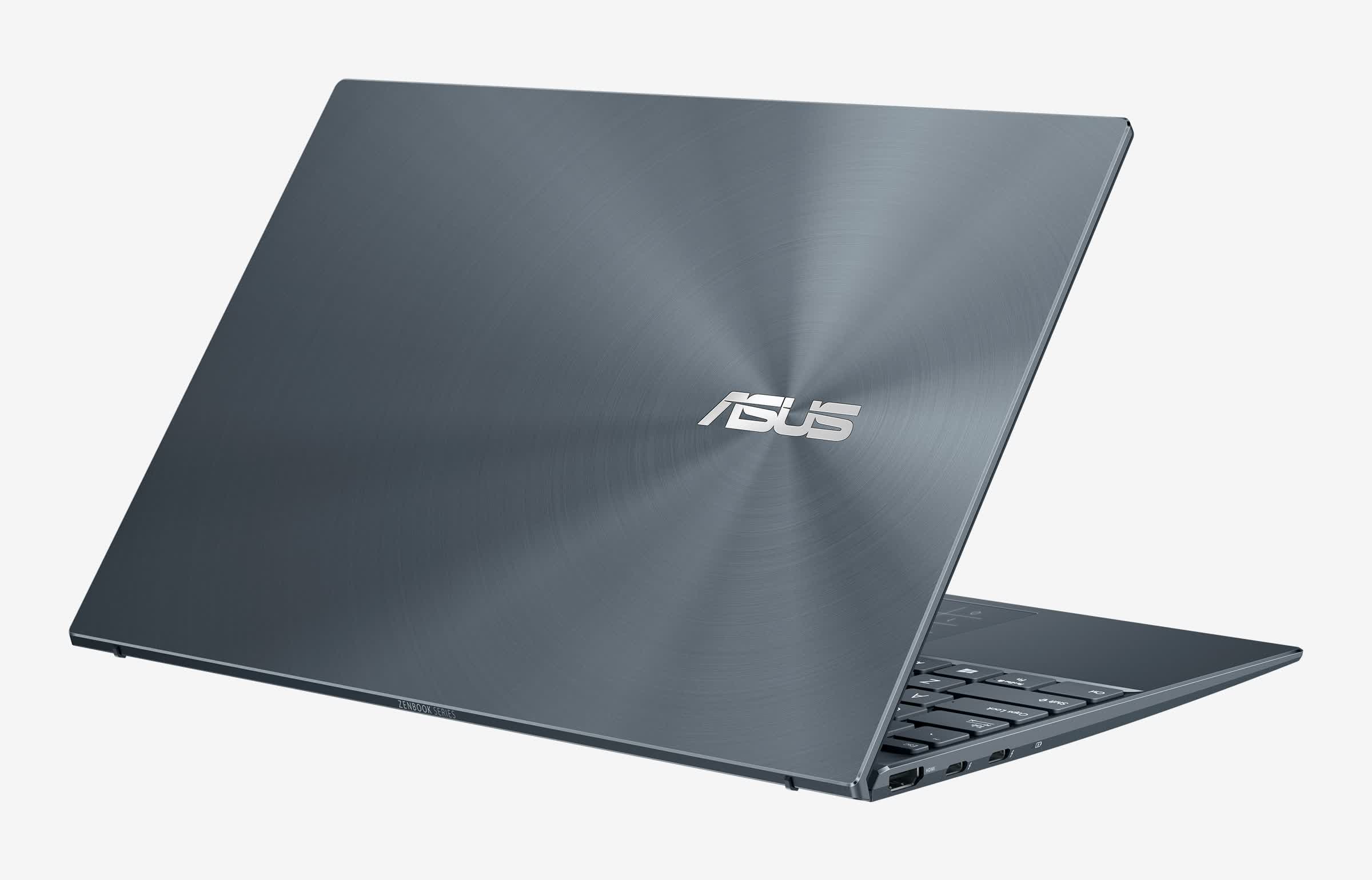
The ZenBook weighs a modest 2.49 pounds and is merely xiii.9mm thick, and so it'south slim and calorie-free plenty to sling into your bag. Build quality is reasonable, with a sturdy base of operations the highlight, only this is one area where the ZenBook's mid-range price is axiomatic – the screen could exist stronger, with besides much movement along the summit border. It'due south not a serious cause for business organisation, but it'due south worth bearing in mind if you're going to take this machine out of the firm. More reassuring is the ZenBook's adherence to MIL-STD-810G standards. This means the machine tin withstand drops, vibrations, and extreme temperatures, then it should exist fine to handle day-to-day life.
Internal access is possible as long as you've got a small plenty Torx screwdriver. However, the simply component that can be accessed is the SSD – the memory chips and wireless module are all soldered to the motherboard.
The left-hand side serves up two USB-C ports that back up Thunderbolt 4, which can provide up to a whopping 40GB/due south, and the ZenBook'due south USB-C ports are also used for charging. The left-mitt side houses the HDMI output. On the right side is a microSD card slot and a full-size USB 3.2 Gen i port. That USB port has a more modest maximum bandwidth of 5GB/s.
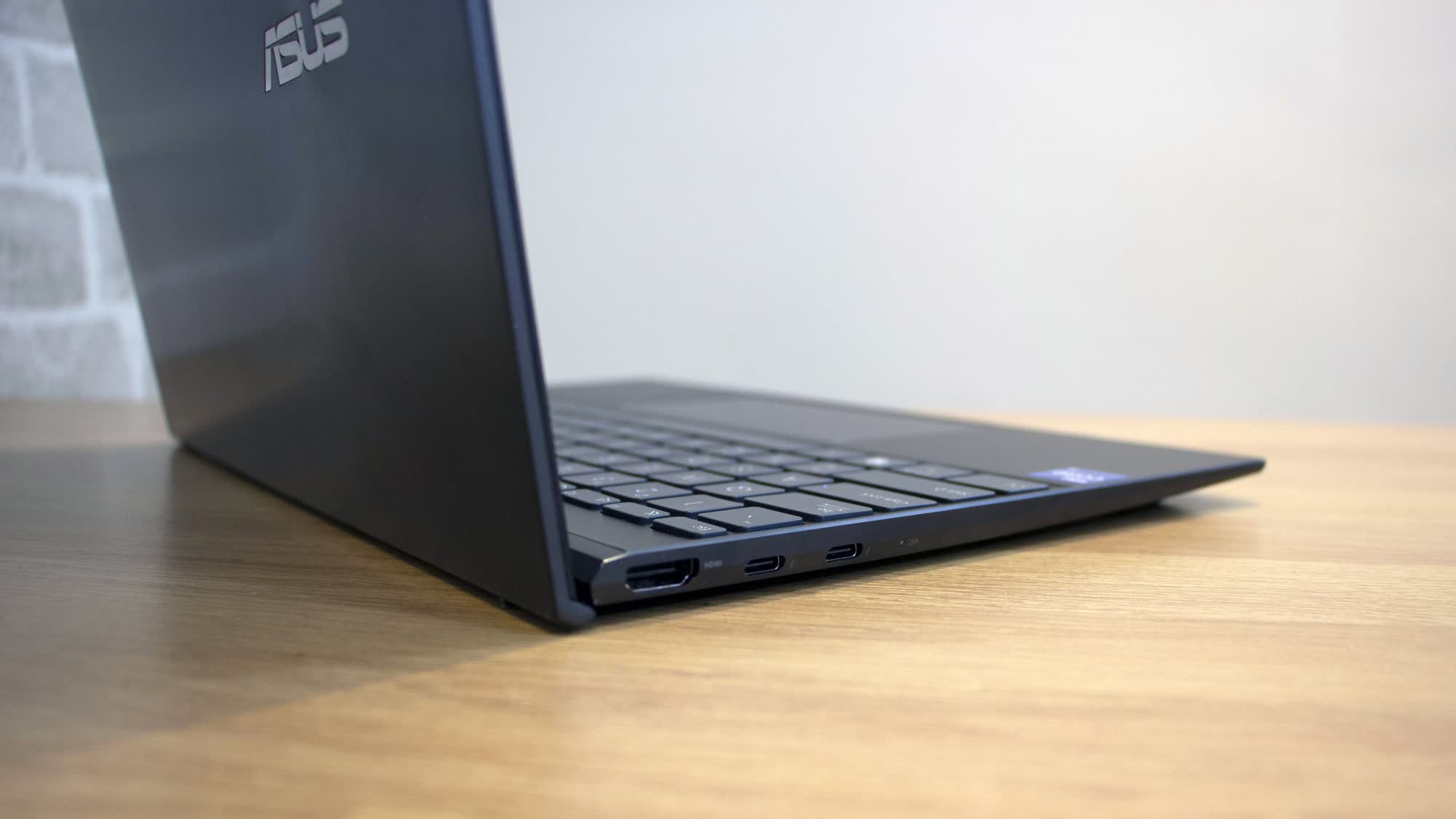
There'due south ane big omission when it comes to connectivity, though – no headphone jack. If you use wireless audio gear that'south fine, merely it'due south an upshot if you lot still utilise wired headphones. Asus includes a USB-C-to-audio adapter, which is helpful only a somewhat clumsy solution. Once you've plugged in the adapter and the charger, that's it for USB-C and Thunderbolt iv connectivity.
Above the display is a 720p webcam that works with Windows Hello. Quality isn't great – it's fine for business concern calls and family catch-ups, but that'due south all. A keyboard shortcut tin can be used to turn the webcam off, simply there'south no physical privacy shutter. There'southward no fingerprint reader on this motorcar, either.
The ZenBook has decent design, but those omissions and its subtle blueprint may give people cause to look elsewhere. We recently reviewed the Acer Swift iii, for example, which costs $1,099 when configured with a prev-gen Core i7 and just $835 when loaded up with a Ryzen 7 4700U. That rig offers good build quality and brighter aluminum design, just no Thunderbolt 4, Iris graphics or light-upwardly trackpad.
If you're willing to stretch to $1,439 you can become a similarly configured Dell XPS thirteen with the 11th-gen CPU and its stunning chassis, which combines aluminum and carbon fiber. That machine has Thunderbolt iv, likewise.
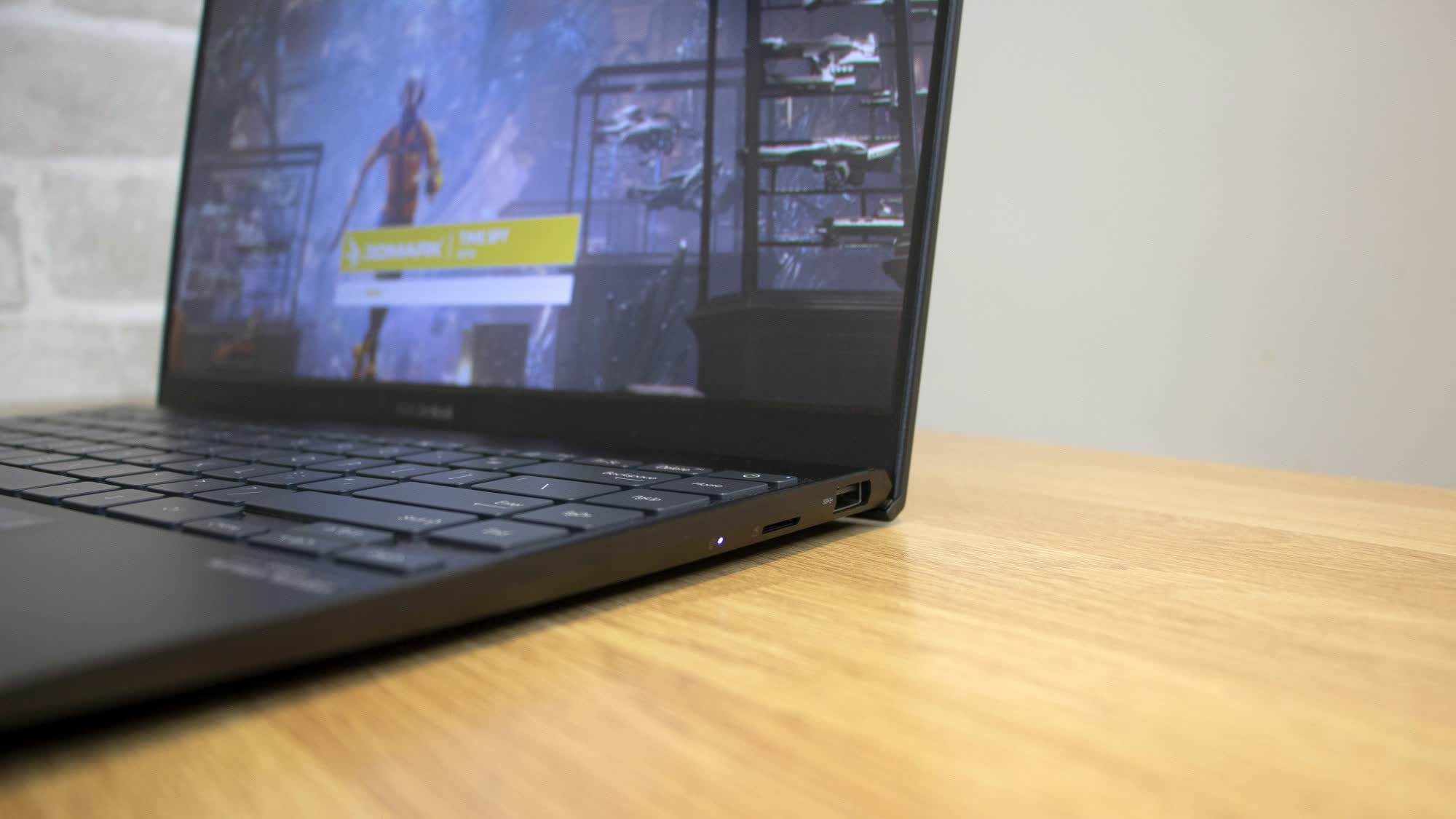
The ZenBook's keyboard is pretty standard for an ultraportable. The Return key isn't double-height, simply Asus has crammed a solid corporeality of functionality in hither regardless – at that place'south a bonus column of keys on the right-paw side that includes Dwelling house, End, PgUp and PgDn buttons, and on the function row you get book, brandish brightness and iii-level white backlight keyboard controls.
A button in the top-right corner of the trackpad activates the Asus NumberPad 2.0, which lays a virtual number pad over the trackpad. You tin can click on the pad to use the numbers while still using the trackpad'southward cadre functionality – it hands differentiated betwixt the two.
The keyboard's buttons are wide and large, with a clear font and a decent 1.4mm of travel. Information technology's an impressive unit of measurement – the keys are slightly concave and have a slightly rubberized surface, so they coddle fingertips well, and the typing activity is fast and balanced. Information technology's a little on the well-baked, and is well-suited to long typing sessions. The simply downside is the noise as they're not exactly quiet.
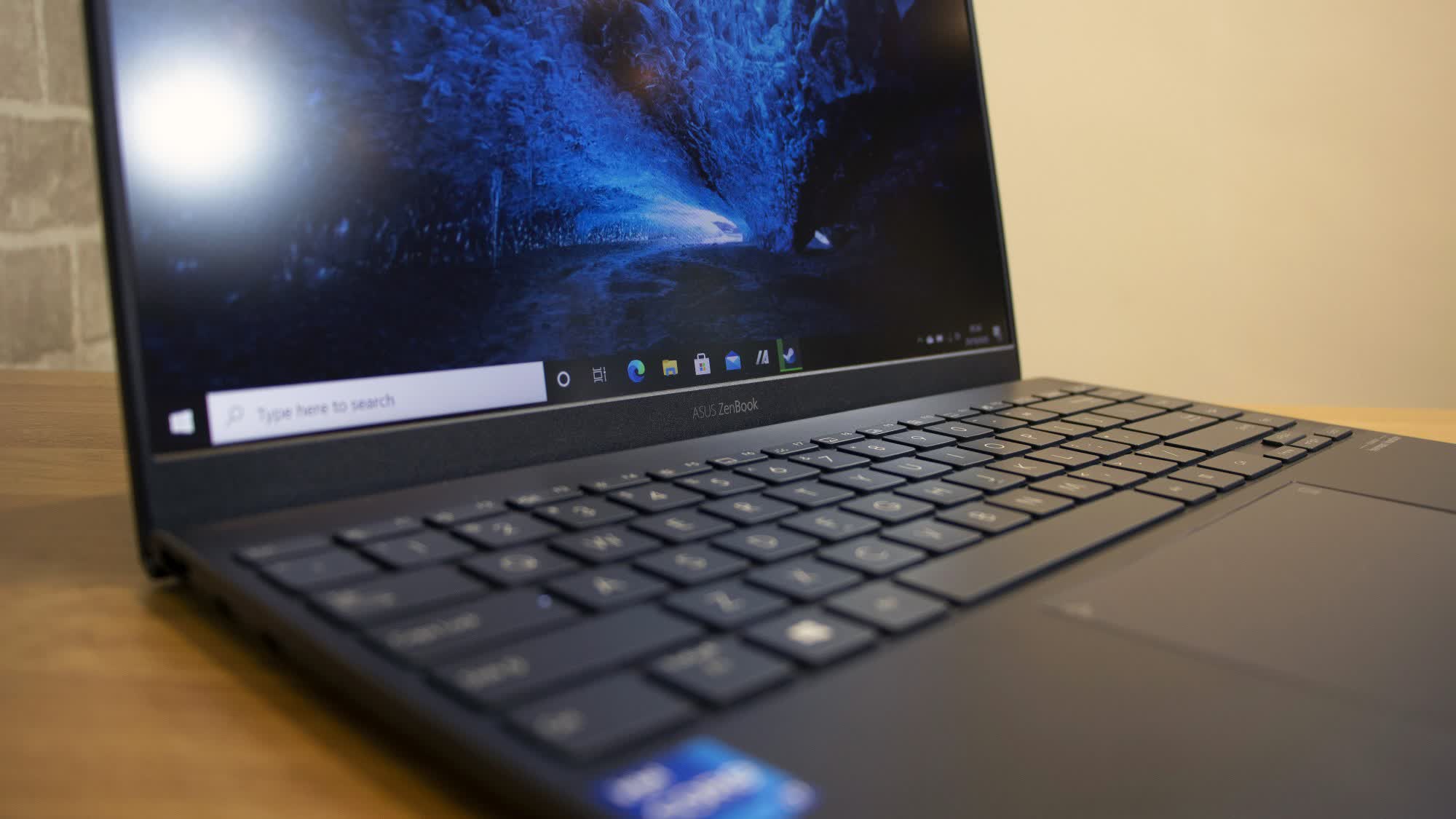
The trackpad is wide and has solid functionality – it has multi-touch gesture support alongside the aforementioned number pad. The glass surface is smooth and responsive, and the ii buttons are fast and shallow.
The ZenBook may take a new Core i7 CPU and a keen sense of exterior style, merely the $1,099 price is pretty affordable. That means the display is modest– it's a fourteen" 1080p IPS panel, but it's non a touchscreen (some may prefer this) and it doesn't take any fancy extras similar a high refresh rate or HDR. It doesn't take the quality to handle the Adobe RGB or DCI-P3 color gamuts, either, so don't expect this display to handle color-sensitive professional person workloads.
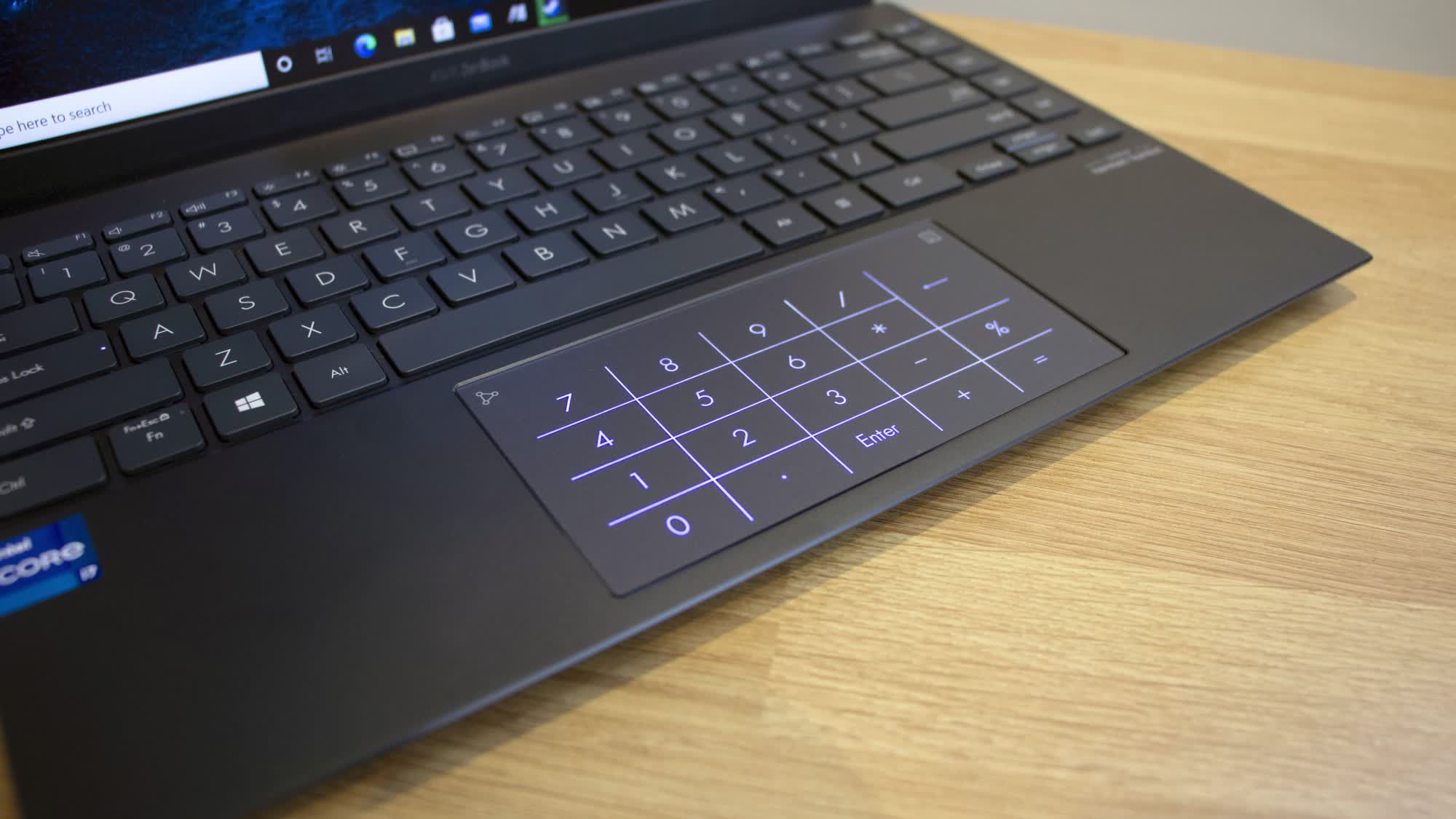
If you're happy enough to stick to the mainstream sRGB gamut, though, the ZenBook serves up great quality. The maximum brightness of 406cd/m2 is loftier enough to handle indoor and outdoor apply, and it's paired with a good black level of 0.25cd/m2, which ways dark areas in movies, TV shows and photos have decent depth.
Those figures create a measured contrast ratio of 1,624:1, which is a tiptop-notch result. It's amend than the vast bulk of IPS displays, and it means that the ZenBook's console delivers huge vibrancy, nuance and depth. Uniformity is great, too – the brightness only deviated by 5% in the corners.
That sRGB colour reproduction is pretty good, too. The Delta E of 0.93 is fantastic – below the point where homo eyes can detect deviations. The color temperature of 6,569K barely differs from the half dozen,500K platonic, and the screen displayed 98% of the sRGB gamut at a moderate volume of 101.5%. They're all top-tier results, and they mean that movies, Tv set shows, games and photos look fantastic – vibrant and accurate. It'south hands good enough to handle mainstream photo editing, too.
The speakers are fine, if not outstanding. They're loud and they've got a surprising bass thump, just mid-range noises manage to be simultaneously harsh and muffled and the top-stop is tinny. It's like shooting fish in a barrel to notice laptops with better sound kit.
Performance
The Core i7-1165G7 is the key component in this machine. Tiger Lake brings significant improvements when compared to the blue firm's final laptop CPUs. The Willow Cove processing cores utilise an improved 10nm manufacturing procedure, which allows the CPU to be more efficient and flexible than older parts.
Chips similar the i7-1165G7 don't accept precise TDPs anymore – instead, they have a thermal window that allows manufacturers to alter a CPU'south power requirements and speeds based on a device's thermal abilities. The i7-1165G7 has a thermal window between 12 and 28W, and that means its base of operations clock can veer between a minor i.2GHz and a decent two.8GHz. Those speeds are bolstered by a Turbo elevation of four.7GHz.
Elsewhere, Tiger Lake includes Intel's Iris Xe graphics core, which has 96 execution units. It'due south an improvement over older Intel integrated GPUs, and hither it's clocked to 1.3GHz. Tiger Lake is rounded out with LPDDR4x memory, PCI-E 4.0 support, and native support for Wi-Fi 6 and Thunderbolt iv.
The ZenBook 14 UX425E theoretically is allowed to run the i7-1165G7 at its full speeds, and the specification is completed past 16GB of dual-aqueduct retentiveness clocked to two,133MHz, a 1TB Intel 660p SSD, dual-ring WiFi 6 and Bluetooth 5.i. If you want to apply wired cyberspace, yous'll need to rely on the included USB adapter.
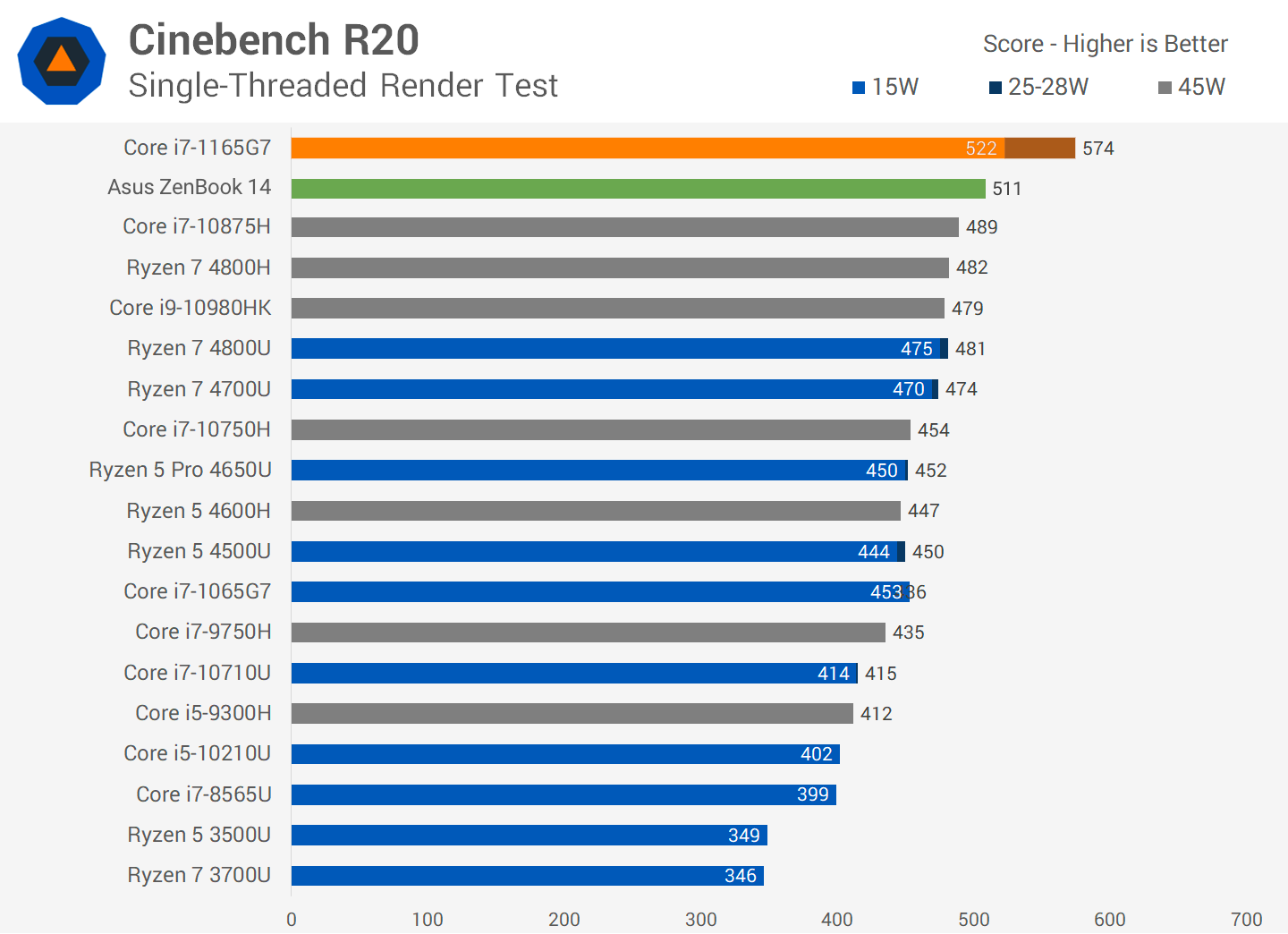
The new chip sounds adept on paper, simply information technology oftentimes couldn't keep up with a competing AMD fleck in benchmarks. In Cinebench R20's unmarried-threaded test the i7-1165G7 scored 511 points – around l points amend than AMD'southward rival Ryzen v 4500U and Ryzen seven 4700U, and 58 points beyond the concluding-gen i7-1065G7. Loading up Cinebench's multi-core test saw the ZenBook score 1,739 points. That'due south underwhelming – more than 1,000 points behind the full-wattage Ryzen 7 4700U, and also behind other i7-1165G7 laptops we recently tested.
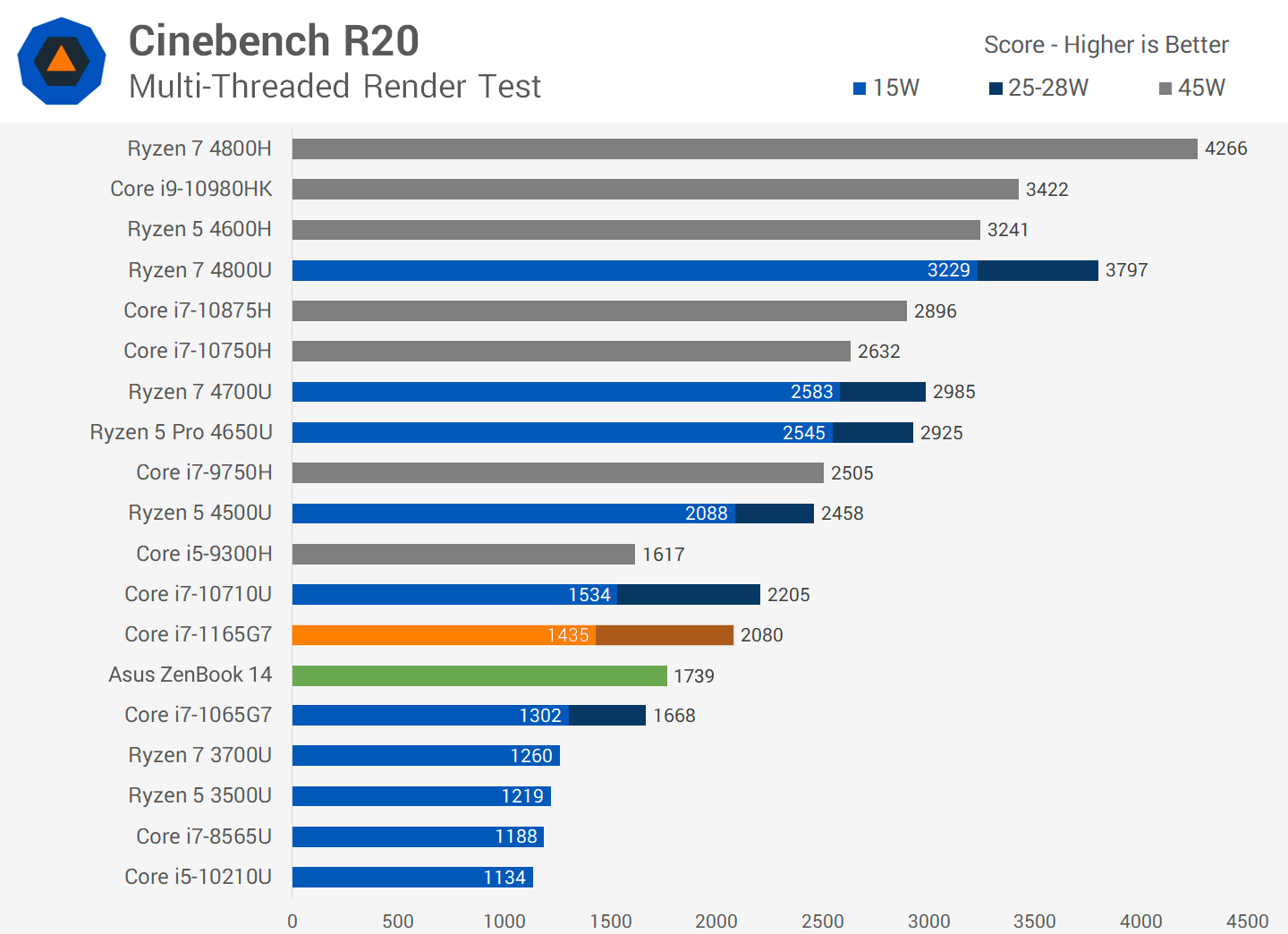
The CPU's below than expected performance tin be explained by the ZenBook's clock speeds and temperatures. During Cinebench'southward single-core exam the CPU peaked at 4.3GHz and rarely got beyond four.1GHz, and in the multi-cadre test it peaked at 3.6GHz, just mostly hovered effectually 2.5GHz. In the single-cadre test the CPU's temperature peaked at 90 degrees, and information technology topped out at 96 degrees in the multi-core benchmark. It'due south clear that the CPU has zip more to give inside the ZenBook.
Farther benchmarks saw this pattern repeat. The Asus' PCMark ten Productivity and Essentials scores of vi,583 and 6,324 are both backside the AMD CPUs and fifty-fifty the i7-1065G7, which indicates the seriousness of this laptop'southward throttling.
In Blender, the Asus and its cut-back quad-cadre CPU took over fifteen minutes to complete the 720p Classroom criterion, with clock speeds ducking down to two.3GHz and and so below 1.9GHz. Its Cryptography effect of xiv.3GB/s outpaced the Ryzen 5 4500U by a couple of gigabytes, but that test commonly favors chips with stronger single-core ability.
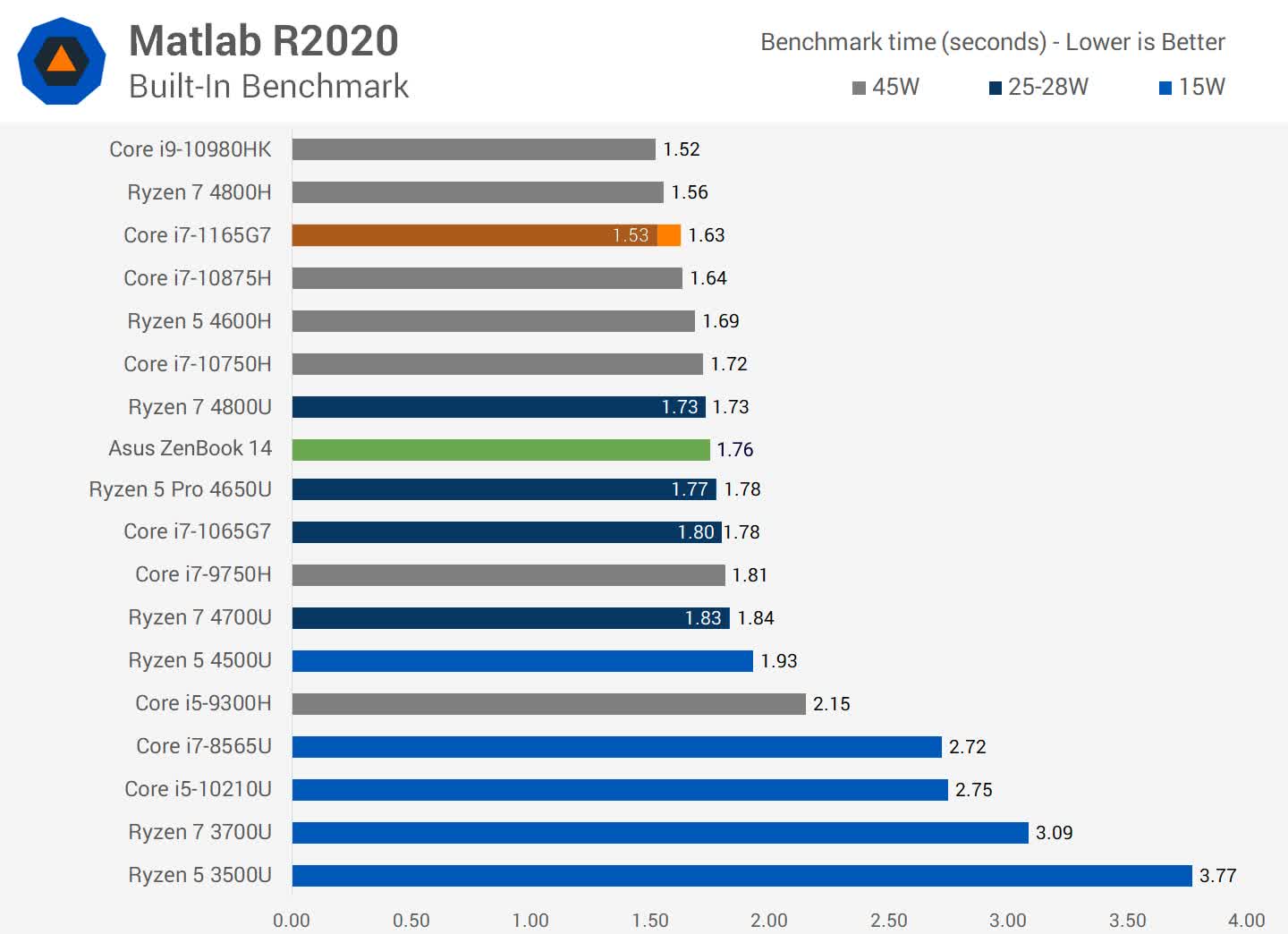
In Matlab, the i7-1165G7 was no faster than last year'due south Core i7 CPU and slower than AMD's fries, the Intel chip was slower in both 7-Nothing benchmarks, and the Intel silicon but managed to beat AMD by a fine margin in the Microsoft Excel test – which relies on single-threaded step. In the graphs you can see the ZenBook's results compared to an average of four other laptops likewise using the Core i7-1165G7.
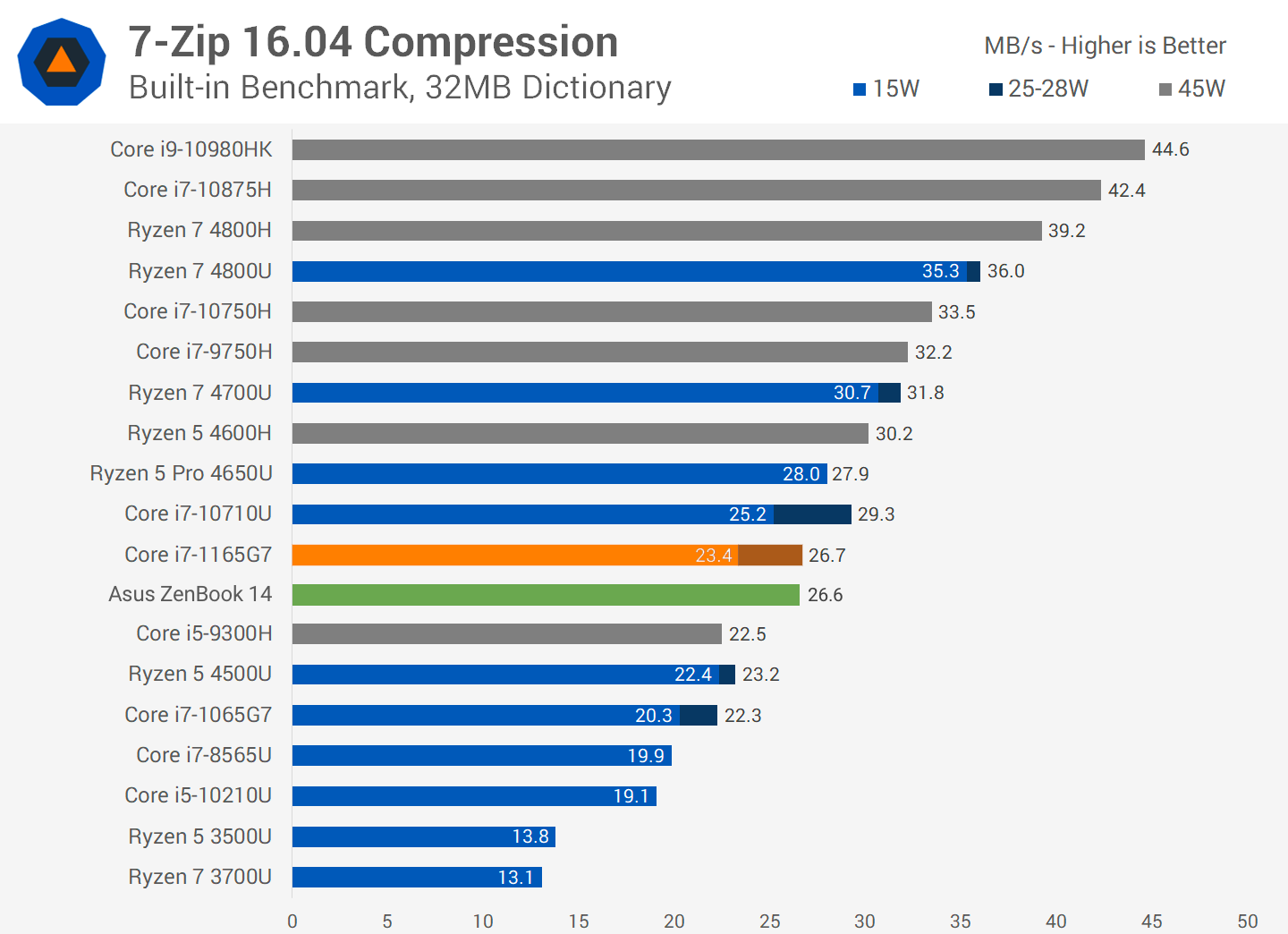
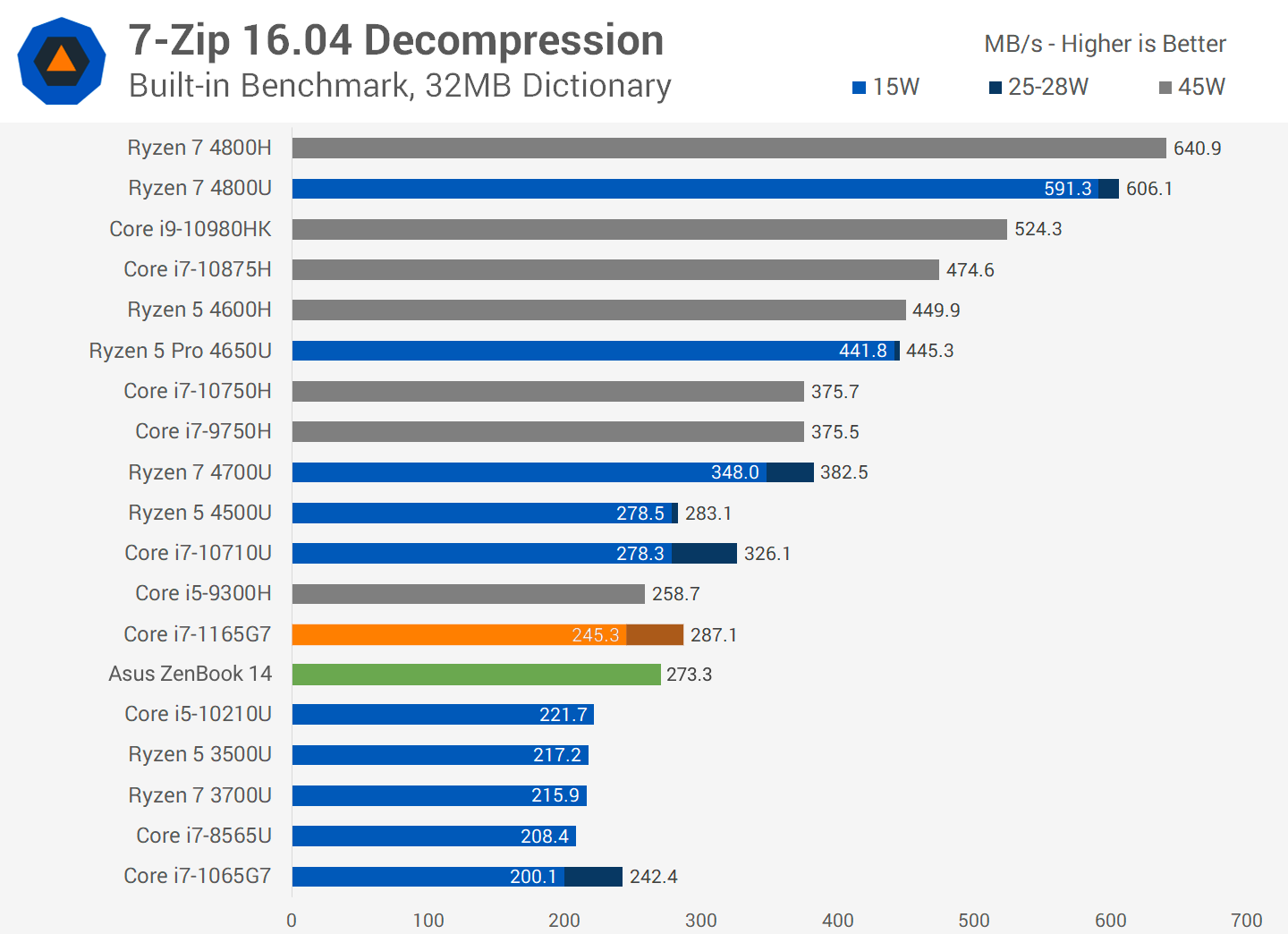
Now, it's an underwhelming set of results, just information technology's non necessarily a concluding issue when information technology comes to mainstream real-world use. The ZenBook's solid single-core functioning and iv hyper-threaded cores mean that at that place's aplenty power for low-terminate and mainstream computing – the ZenBook zipped around browsers with loads of tabs, office applications, and other desktop apps with no problems and is just as effective as an AMD-powered machine.

The SSD's read and write speeds of 1,757MB/southward and 1,761MB/south don't make employ of the ZenBook'south PCI-E 4.0 connection, but they're fast plenty to keep the automobile feeling snappy. Don't try and rely on this machine for tougher workloads, like content-creation or intense multi-tasking, but then again ultraportables are not really meant as desktop replacement machines.
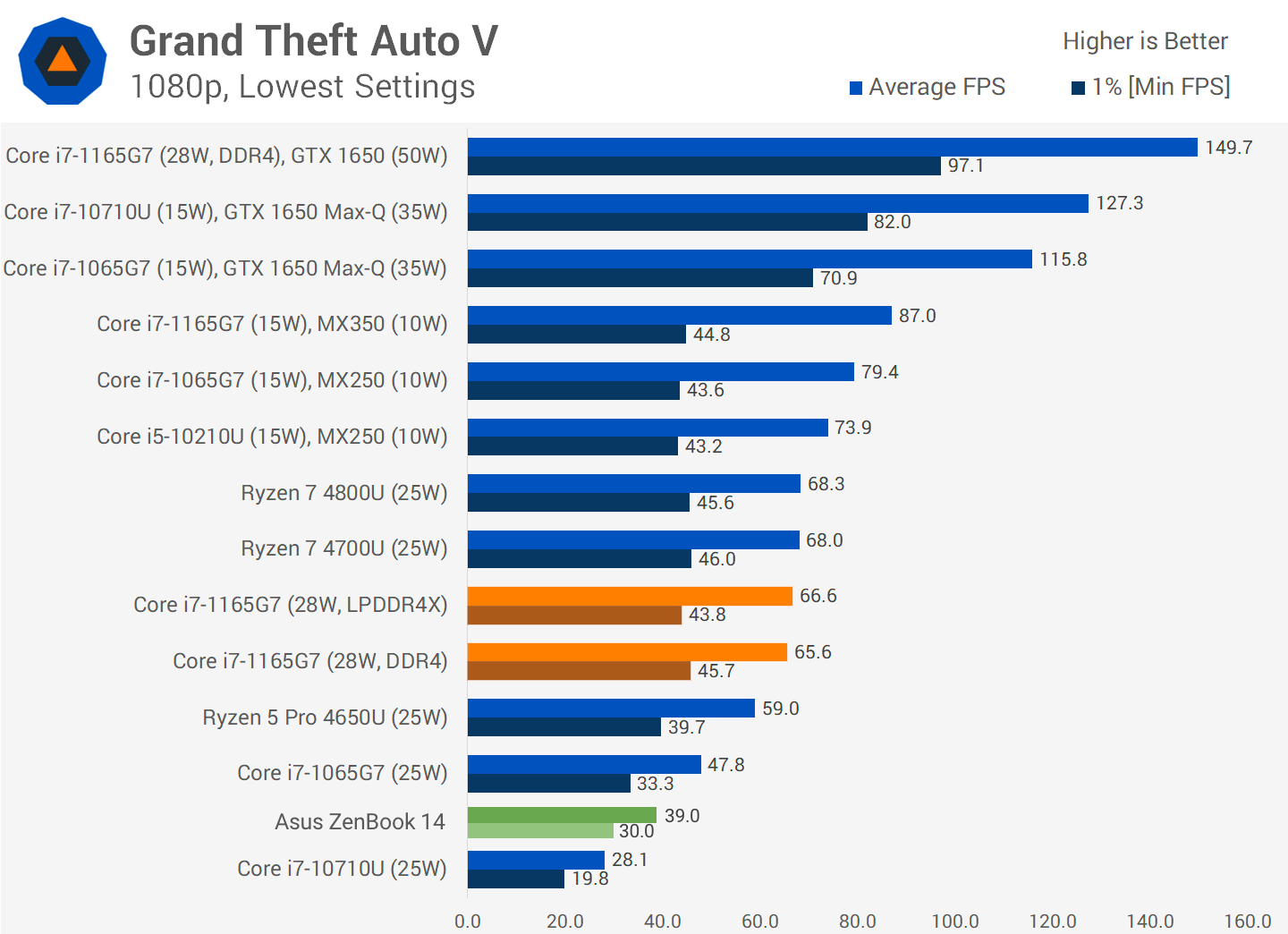
Intel's updated graphics fleck proved underwhelming in 1080p gaming – at least compared to the Vega 6 and 7 hardware inside Ryzen 4000 chips. In GTA V the Intel-based Asus delivered an average of 28fps – but AMD'southward chips were more than twice every bit fast.
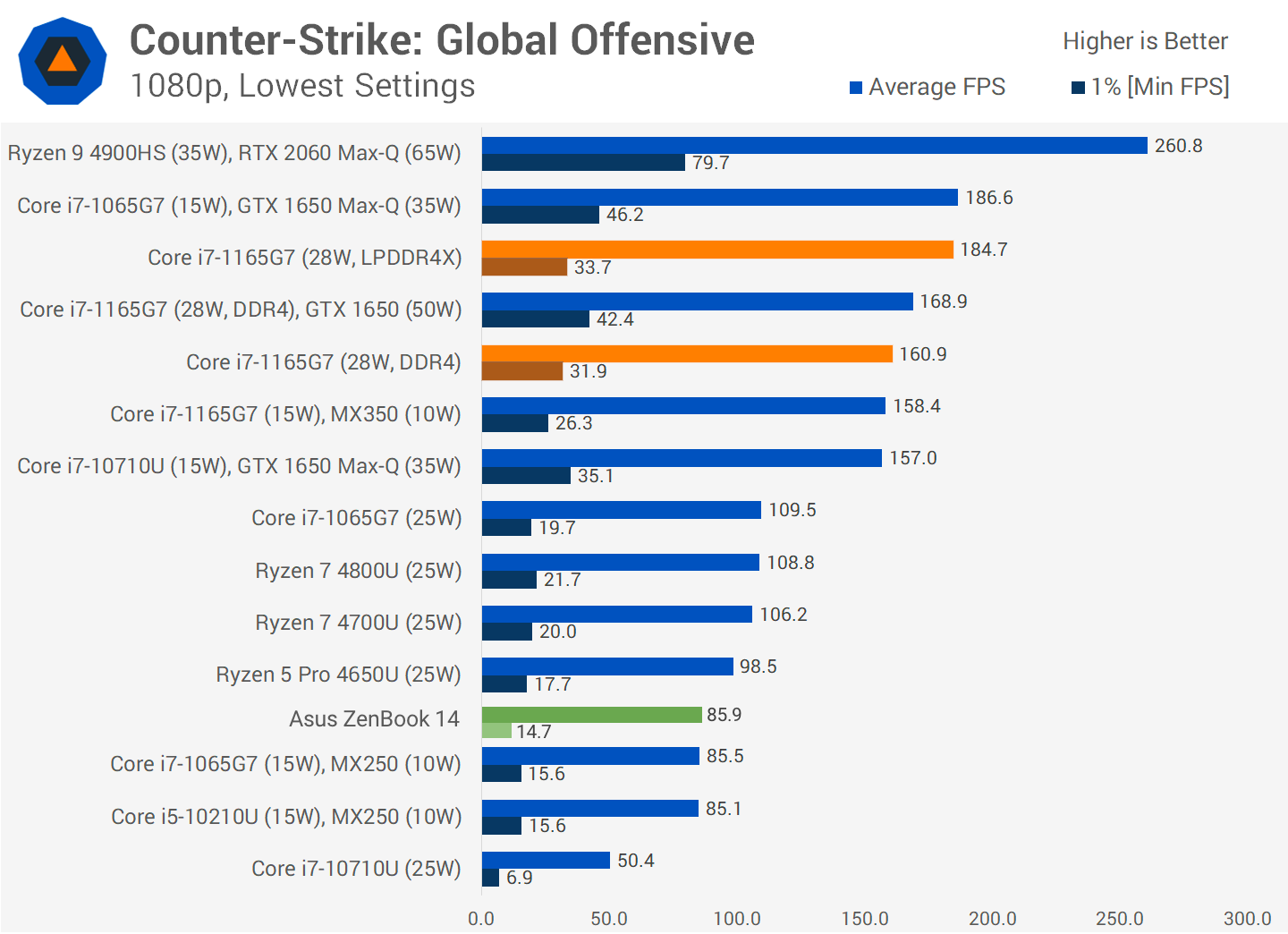
In Civilization Half dozen, the Asus laptop averaged 21fps, which is miles behind AMD, just that game is very CPU-intensive and we've already seen the Intel CPU throttling in this laptop, so that's no surprise. The UX425 fell backside AMD-based laptops in CS:GO and F1 2022, too, and the Intel chip broadly returned the same sort of performance as its predecessor.
The Asus will handle coincidental titles and older games, and information technology'll only cope with modern software if you lot drastically reduce the graphics settings. If you want any sort of gaming ability in an ultraportable, notice i with an AMD Renoir chip.
Battery Life
There are some positives to be establish elsewhere. The Asus is a decent thermal performer: fan dissonance is modest and the exterior remains absurd throughout. Information technology'southward just a shame that the decent thermal power comes at the expense of clock speed.
Its bombardment life is more than than reasonable, too. The ZenBook has a 67Wh power unit of measurement, and in a work criterion the ZenBook lasted for 18 hours and 45 minutes with the screen at half effulgence and 13 hours and 7 minutes with the screen at maximum effulgence.
When playing video at full brightness the Asus handled ten hours and 14 minutes, and at one-half effulgence that time was extended to beyond fifteen hours. Information technology'due south dandy longevity – no matter what you lot're doing with this auto you'll hands become through a working solar day, and you'll probably be able to handle your commute and an evening on the sofa as well.
Wrap Up
The Asus ZenBook 14 UX425 has a decent $1,099 price tag as configured, and goes down to $899 for the base model (8GB RAM/512GB SSD) that keeps the same Cadre i7 CPU.
At that place are several areas where this laptop undoubtedly excels: the brandish is tremendous if you're happy to stick with a 1080p, non-touch and sRGB-friendly panel; the keyboard and trackpad are nifty, and the chassis is expert-looking, slim and light. Its battery life is stellar, and the Tiger Lake CPU brings information technology on with Thunderbolt four and native Wi-Fi vi.
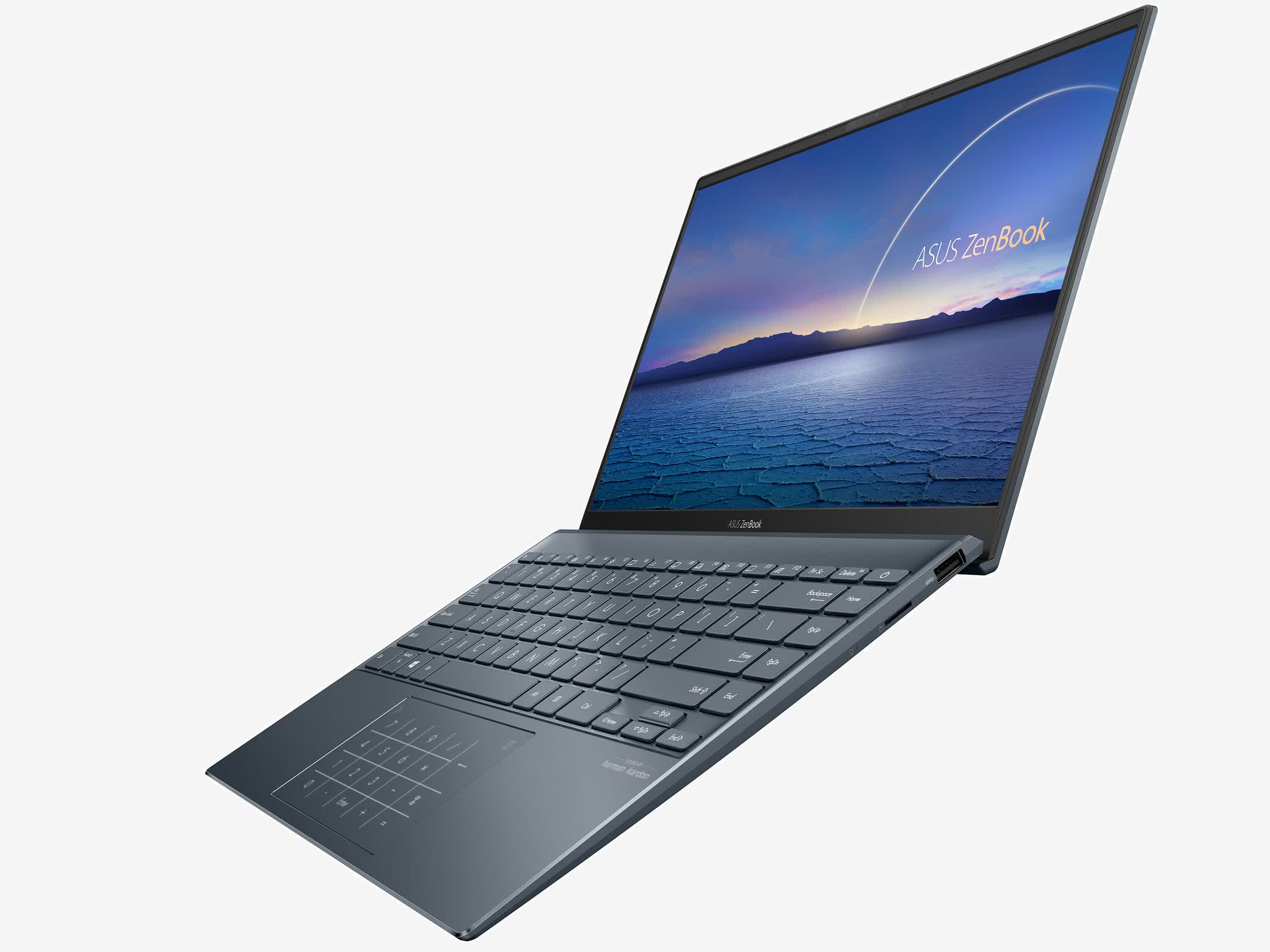
Normally a new CPU would exist a cause for celebration on the performance department, but the Tiger Lake silicon is non fully utilized in this machine. Single-core performance is skilful and the ZenBook is snappy in everyday utilise, but the scrap speedily hits its thermal limits and can never stretch its legs. Multi-core performance was never going to be a contest against AMD, the ZenBook can be used casually for heavy multitasking, only information technology's no friction match for other notebooks ameliorate equipped to perform every bit desktop replacements.
Ultimately, there's withal plenty of reasons to purchase the ZenBook – if you want an ultraportable that delivers on ultraportable aspects and value, the UX425E does evangelize great battery life, screen quality and ergonomics in a good-looking package.
Shopping Shortcuts
- Asus ZenBook 14 UX425 on Amazon, Newegg, B&H Photograph
- Intel Core i7-1165G7 Tiger Lake Laptops on Amazon
- Intel Cadre i7-1185G7 Tiger Lake Laptops on Amazon
- Ryzen 7 4800U Laptops on Amazon
- Ryzen seven 4700U Laptops on Amazon
Source: https://www.techspot.com/review/2152-asus-zenbook-14/
Posted by: trainordebtled.blogspot.com


0 Response to "Asus ZenBook 14 UX425E Review"
Post a Comment